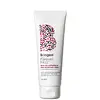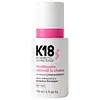What's inside
What's inside
 Key Ingredients
Key Ingredients

 Benefits
Benefits

 Concerns
Concerns

 Ingredients Side-by-side
Ingredients Side-by-side

Water
Skin ConditioningAloe Barbadensis Leaf Juice
Skin ConditioningPolyquaternium-37
Rosa Canina Fruit Oil
EmollientArgania Spinosa Kernel Oil
EmollientCocos Nucifera Oil
MaskingLaminaria Saccharina Extract
Skin ProtectingBambusa Arundinacea Leaf Extract
Skin ConditioningPanthenol
Skin ConditioningTrametes Versicolor Extract
Tocopheryl Acetate
AntioxidantGlycine Soja Oil
EmollientPropylene Glycol Dicaprylate/Dicaprate
EmollientHydrolyzed Corn Protein
Skin ConditioningHydrolyzed Wheat Protein
Skin ConditioningHydrolyzed Soy Protein
HumectantPPG-1 Trideceth-6
Skin ConditioningSorbitol
HumectantGlycerin
HumectantLeuconostoc/Radish Root Ferment Filtrate
AntimicrobialCitrus Aurantium Dulcis Peel Oil
MaskingCitrus Paradisi Peel Oil
MaskingCitrus Limon Peel Oil
MaskingCitrus Tangerina Peel Oil
MaskingAbies Sibirica Oil
MaskingPolyquaternium-10
Cetrimonium Chloride
AntimicrobialParfum
MaskingDehydroacetic Acid
PreservativeBenzyl Alcohol
PerfumingWater, Aloe Barbadensis Leaf Juice, Polyquaternium-37, Rosa Canina Fruit Oil, Argania Spinosa Kernel Oil, Cocos Nucifera Oil, Laminaria Saccharina Extract, Bambusa Arundinacea Leaf Extract, Panthenol, Trametes Versicolor Extract, Tocopheryl Acetate, Glycine Soja Oil, Propylene Glycol Dicaprylate/Dicaprate, Hydrolyzed Corn Protein, Hydrolyzed Wheat Protein, Hydrolyzed Soy Protein, PPG-1 Trideceth-6, Sorbitol, Glycerin, Leuconostoc/Radish Root Ferment Filtrate, Citrus Aurantium Dulcis Peel Oil, Citrus Paradisi Peel Oil, Citrus Limon Peel Oil, Citrus Tangerina Peel Oil, Abies Sibirica Oil, Polyquaternium-10, Cetrimonium Chloride, Parfum, Dehydroacetic Acid, Benzyl Alcohol
Water
Skin ConditioningCellulose Gum
Emulsion StabilisingIsopentyldiol
HumectantPropanediol
SolventCetearyl Alcohol
EmollientIsopropyl Palmitate
EmollientSodium Benzoate
MaskingC13-15 Alkane
SolventSh-Oligopeptide-78
Laurdimonium Hydroxypropyl Hydrolyzed Barley Protein
HumectantHelianthus Annuus Seed Oil
EmollientOryza Sativa Bran Extract
Skin ConditioningHelianthus Annuus Extract
EmollientRosmarinus Officinalis Leaf Extract
AntimicrobialTocopherol
AntioxidantBehentrimonium Chloride
PreservativeCetrimonium Chloride
AntimicrobialGluconolactone
Skin ConditioningArginine
MaskingCoco-Glucoside
CleansingLactic Acid
BufferingCellulose
AbsorbentC12-20 Alkyl Glucoside
EmulsifyingCitric Acid
BufferingPotassium Sorbate
PreservativeBenzyl Alcohol
PerfumingIsopropyl Alcohol
SolventC14-22 Alcohols
Emulsion StabilisingParfum
MaskingAmyl Salicylate
PerfumingBenzyl Salicylate
PerfumingCitronellol
PerfumingCitrus Aurantium Peel Oil
Dimethyl Phenylethyl Carbinyl Acetate
PerfumingGeraniol
PerfumingGeranyl Acetate
PerfumingIsoeugenyl Acetate
PerfumingLimonene
PerfumingLinalool
PerfumingLinalyl Acetate
MaskingPinene
MaskingTetramethyl Acetyloctahydronaphthalenes
MaskingVanillin
MaskingWater, Cellulose Gum, Isopentyldiol, Propanediol, Cetearyl Alcohol, Isopropyl Palmitate, Sodium Benzoate, C13-15 Alkane, Sh-Oligopeptide-78, Laurdimonium Hydroxypropyl Hydrolyzed Barley Protein, Helianthus Annuus Seed Oil, Oryza Sativa Bran Extract, Helianthus Annuus Extract, Rosmarinus Officinalis Leaf Extract, Tocopherol, Behentrimonium Chloride, Cetrimonium Chloride, Gluconolactone, Arginine, Coco-Glucoside, Lactic Acid, Cellulose, C12-20 Alkyl Glucoside, Citric Acid, Potassium Sorbate, Benzyl Alcohol, Isopropyl Alcohol, C14-22 Alcohols, Parfum, Amyl Salicylate, Benzyl Salicylate, Citronellol, Citrus Aurantium Peel Oil, Dimethyl Phenylethyl Carbinyl Acetate, Geraniol, Geranyl Acetate, Isoeugenyl Acetate, Limonene, Linalool, Linalyl Acetate, Pinene, Tetramethyl Acetyloctahydronaphthalenes, Vanillin
 Reviews
Reviews

Ingredients Explained
These ingredients are found in both products.
Ingredients higher up in an ingredient list are typically present in a larger amount.
Benzyl Alcohol is most commonly used as a preservative. It also has a subtle, sweet smell. Small amounts of Benzyl Alcohol is not irritating and safe to use in skincare products. Most Benzyl Alcohol is derived from fruits such as apricots.
Benzyl Alcohol has both antibacterial and antioxidant properties. These properties help lengthen the shelf life of products. Benzyl Alcohol is a solvent and helps dissolve other ingredients. It can also improve the texture and spreadability.
Alcohol comes in many different forms. Different types of alcohol will have different effects on skin. This ingredient is an astringent alcohol.
Using high concentrations of these alcohols are drying on the skin. They may strip away your skin's natural oils and even damage your skin barrier. Astringent alcohols may also irritate skin.
Other types of astringent alcohols include:
According to the National Rosacea Society based in the US, you should be mindful of products with these alcohols in the top half of ingredients.
Any type of sanitizing product will have high amounts of alcohol to help kill bacteria and viruses.
Learn more about Benzyl AlcoholThis ingredient is a preservative, antimicrobial, and emulsifier. It is often used in cosmetics for its ability to cleanse, condition, and reduce static.
Cetrimonium chloride is a quaternary ammonium salt, meaning it has a water-soluble structure.
Parfum is a catch-all term for an ingredient or more that is used to give a scent to products.
Also called "fragrance", this ingredient can be a blend of hundreds of chemicals or plant oils. This means every product with "fragrance" or "parfum" in the ingredients list is a different mixture.
For instance, Habanolide is a proprietary trade name for a specific aroma chemical. When used as a fragrance ingredient in cosmetics, most aroma chemicals fall under the broad labeling category of “FRAGRANCE” or “PARFUM” according to EU and US regulations.
The term 'parfum' or 'fragrance' is not regulated in many countries. In many cases, it is up to the brand to define this term.
For instance, many brands choose to label themselves as "fragrance-free" because they are not using synthetic fragrances. However, their products may still contain ingredients such as essential oils that are considered a fragrance by INCI standards.
One example is Calendula flower extract. Calendula is an essential oil that still imparts a scent or 'fragrance'.
Depending on the blend, the ingredients in the mixture can cause allergies and sensitivities on the skin. Some ingredients that are known EU allergens include linalool and citronellol.
Parfum can also be used to mask or cover an unpleasant scent.
The bottom line is: not all fragrances/parfum/ingredients are created equally. If you are worried about fragrances, we recommend taking a closer look at an ingredient. And of course, we always recommend speaking with a professional.
Learn more about ParfumWater. It's the most common cosmetic ingredient of all. You'll usually see it at the top of ingredient lists, meaning that it makes up the largest part of the product.
So why is it so popular? Water most often acts as a solvent - this means that it helps dissolve other ingredients into the formulation.
You'll also recognize water as that liquid we all need to stay alive. If you see this, drink a glass of water. Stay hydrated!
Learn more about Water